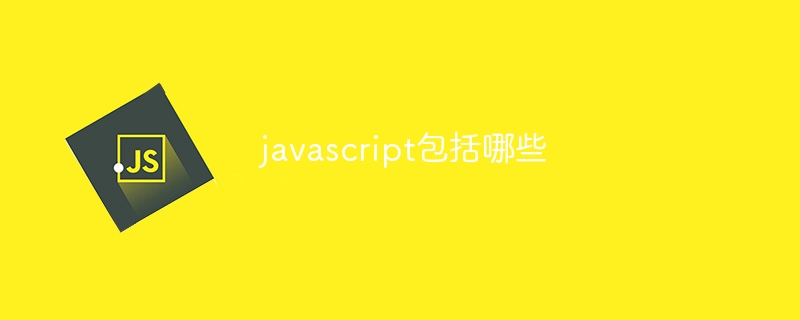What does javascript include?
The main components of JavaScript include: core syntax, standard library, document object model, asynchronous programming, modularity, development tools, and frameworks and libraries that enable it to build interactive applications.

Main components of JavaScript
JavaScript is a powerful programming language that is widely used for the Web , mobile applications and server-side environments provide interactivity and dynamics. Its key components include:
1. Core syntax
- Variables and data types
- Operators and expressions
- Statements and code blocks
- Function and object
2. Standard library (ECMAScript)
- Array, object , strings, numbers and other data structures
- Commonly used functions (such as Math.max())
- Built-in objects (such as Math, Date)
3. Document Object Model (DOM)
- A tree-like data structure that represents the structure of an HTML document
- The ability to manipulate HTML elements, styles and events
- Used to create and modify web content
4. Asynchronous programming
- Event loops and event listeners
- Callback functions and Promise
- Used to handle asynchronous operations
5. Modularization
- CommonJS, AMD and ES modules
- Organize code into reusable modules
- Promote code sharing and maintenance
6. Development tools
- Debugging 7. Frameworks and Libraries
- Web frameworks such as React and Vue.js
They provide pre-built components and functions to simplify JavaScript development
- Together these core components make up JavaScript, making it a powerful language capable of building dynamic and interactive applications.
The above is the detailed content of What does javascript include?. For more information, please follow other related articles on the PHP Chinese website!

Hot AI Tools

Undresser.AI Undress
AI-powered app for creating realistic nude photos

AI Clothes Remover
Online AI tool for removing clothes from photos.

Undress AI Tool
Undress images for free

Clothoff.io
AI clothes remover

Video Face Swap
Swap faces in any video effortlessly with our completely free AI face swap tool!

Hot Article

Hot Tools

Notepad++7.3.1
Easy-to-use and free code editor

SublimeText3 Chinese version
Chinese version, very easy to use

Zend Studio 13.0.1
Powerful PHP integrated development environment

Dreamweaver CS6
Visual web development tools

SublimeText3 Mac version
God-level code editing software (SublimeText3)

Hot Topics
 How to add functions to buttons for vue
Apr 08, 2025 am 08:51 AM
How to add functions to buttons for vue
Apr 08, 2025 am 08:51 AM
You can add a function to the Vue button by binding the button in the HTML template to a method. Define the method and write function logic in the Vue instance.
 How to jump to the div of vue
Apr 08, 2025 am 09:18 AM
How to jump to the div of vue
Apr 08, 2025 am 09:18 AM
There are two ways to jump div elements in Vue: use Vue Router and add router-link component. Add the @click event listener and call this.$router.push() method to jump.
 How to jump a tag to vue
Apr 08, 2025 am 09:24 AM
How to jump a tag to vue
Apr 08, 2025 am 09:24 AM
The methods to implement the jump of a tag in Vue include: using the a tag in the HTML template to specify the href attribute. Use the router-link component of Vue routing. Use this.$router.push() method in JavaScript. Parameters can be passed through the query parameter and routes are configured in the router options for dynamic jumps.
 How to pass parameters for vue function
Apr 08, 2025 am 07:36 AM
How to pass parameters for vue function
Apr 08, 2025 am 07:36 AM
There are two main ways to pass parameters to Vue.js functions: pass data using slots or bind a function with bind, and provide parameters: pass parameters using slots: pass data in component templates, accessed within components and used as parameters of the function. Pass parameters using bind binding: bind function in Vue.js instance and provide function parameters.
 Netflix's Frontend: Examples and Applications of React (or Vue)
Apr 16, 2025 am 12:08 AM
Netflix's Frontend: Examples and Applications of React (or Vue)
Apr 16, 2025 am 12:08 AM
Netflix uses React as its front-end framework. 1) React's componentized development model and strong ecosystem are the main reasons why Netflix chose it. 2) Through componentization, Netflix splits complex interfaces into manageable chunks such as video players, recommendation lists and user comments. 3) React's virtual DOM and component life cycle optimizes rendering efficiency and user interaction management.
 React vs. Vue: Which Framework Does Netflix Use?
Apr 14, 2025 am 12:19 AM
React vs. Vue: Which Framework Does Netflix Use?
Apr 14, 2025 am 12:19 AM
Netflixusesacustomframeworkcalled"Gibbon"builtonReact,notReactorVuedirectly.1)TeamExperience:Choosebasedonfamiliarity.2)ProjectComplexity:Vueforsimplerprojects,Reactforcomplexones.3)CustomizationNeeds:Reactoffersmoreflexibility.4)Ecosystema
 React, Vue, and the Future of Netflix's Frontend
Apr 12, 2025 am 12:12 AM
React, Vue, and the Future of Netflix's Frontend
Apr 12, 2025 am 12:12 AM
Netflix mainly uses React as the front-end framework, supplemented by Vue for specific functions. 1) React's componentization and virtual DOM improve the performance and development efficiency of Netflix applications. 2) Vue is used in Netflix's internal tools and small projects, and its flexibility and ease of use are key.
 How to use push function for vue
Apr 08, 2025 am 07:39 AM
How to use push function for vue
Apr 08, 2025 am 07:39 AM
The push() function in Vue is used to add new elements to an array, modify the original array and return a new length. Usage method: Define the array, use the push() function to add elements, and the new element will be added to the end of the array. Example: const arr = ['a', 'b', 'c']; arr.push('d'); Returns the new array: ["a", "b", "c", "d"].






